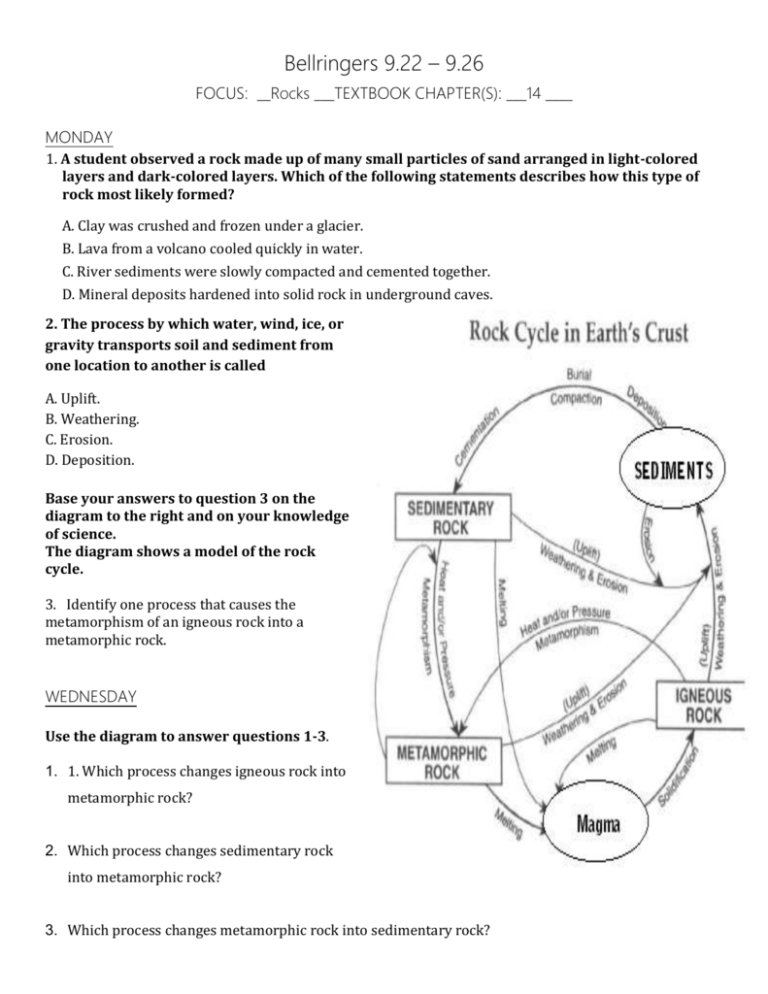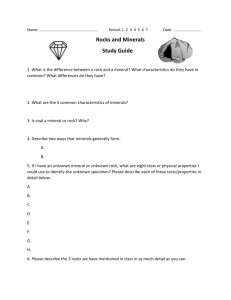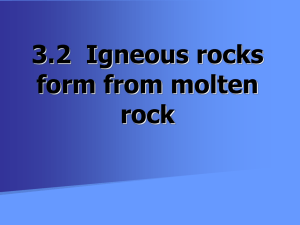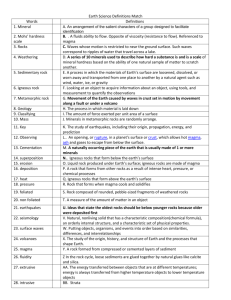Bell Ringer 9.22
advertisement

Bellringers 9.22 – 9.26 FOCUS: __Rocks ___TEXTBOOK CHAPTER(S): ___14 ____ MONDAY 1. A student observed a rock made up of many small particles of sand arranged in light-colored layers and dark-colored layers. Which of the following statements describes how this type of rock most likely formed? A. Clay was crushed and frozen under a glacier. B. Lava from a volcano cooled quickly in water. C. River sediments were slowly compacted and cemented together. D. Mineral deposits hardened into solid rock in underground caves. 2. The process by which water, wind, ice, or gravity transports soil and sediment from one location to another is called A. Uplift. B. Weathering. C. Erosion. D. Deposition. Base your answers to question 3 on the diagram to the right and on your knowledge of science. The diagram shows a model of the rock cycle. 3. Identify one process that causes the metamorphism of an igneous rock into a metamorphic rock. WEDNESDAY Use the diagram to answer questions 1-3. 1. 1. Which process changes igneous rock into metamorphic rock? 2. Which process changes sedimentary rock into metamorphic rock? 3. Which process changes metamorphic rock into sedimentary rock? THURSDAY Read the articles using CLOSE READING STRATEGIES and answer the questions based on the information and what you know. Common Igneous Rocks and Their Uses http://www.buzzle.com/articles/igneous-rock-uses.html In nature, there are three main kinds of rocks, namely, the igneous rocks, sedimentary rocks and metamorphic rocks. They are classified based on the rock formation processes. Directly or indirectly, all types of rocks are derived from the igneous type. For instance, igneous rocks after being subjected to extremely high pressure result in metamorphic rocks. As per geological data, more than 90 % of the upper portion of earth's crust comprises igneous rocks. Here, we will focus on the basics of igneous rocks and their uses. The term 'igneous' is derived from the Latin word for fire (ignis). Igneous rocks are formed from the hot, molten material (magma) present under the earth crust. Cooling of magma leads to the formation of igneous rocks. And if the solidification process takes place underneath the earth's surface, intrusive or plutonic rocks are formed. In contrary to this, extrusive or volcanic rocks are formed on the earth's surface. Over here, magma reaches the earth's surface through volcanic eruption (as lava), and cools down to form volcanic rocks. Obsidian rock is formed externally by rapid cooling of lava, thus allowing minimal crystallization. It is a natural, amorphous glass, which occurs in association with rhyolite. This volcanic glass is used in making scalpel blades, ornamental stones and decorative specimens. With reference to its properties, obsidian rock is grouped under mineraloid, meaning a mineral like substance that lacks distinctive crystals. 1. Approximately what percentage of the Earth’s crust is made of IGNEOUS rocks? _____________________ 2. Which type of igneous rock is helpful for surgeons needing a sharp instrument? Cite your evidence from the text. 3. Why do some types of igneous rocks, specifically EXTRUSIVE (created above the surface of the Earth), have holes in them?









